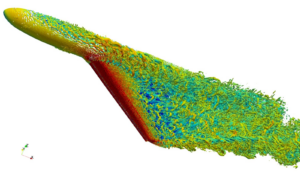High Fidelity Aeroelastic Simulation of the SFB 401 Wing in Flight Conditions
Description of the Problem
In addition to studying shock buffet in our first Lighthouse Case, certifying aircraft requires understanding its impact on wing structural dynamics, how air forces move or stress the wing. LHC2 consists of performing a high fidelity aeroelastic simulation of the SFB 401 wing in a transonic regime (Ma = 0.8, just below the speed of sound) using existing large eddy simulation (LES) models for compressive flows. This case study is also known by the research community as the HIRENASD wing model.

Scientific Relevance and Impact
Coupling advanced LES models with disciplines such as structural dynamics has not yet received much attention. LHC2 addresses several existing methodology gaps according to the NASA Guide for Aircraft Certification, including:
- understanding of non-linearities appearing in transonic regimes for real wing reference configurations,
- accurate determination of aeroelastic deformation in flight conditions,
- computational advances for coupled problems towards Exascale Computing.
Most of these gaps exist due to lack of development of computational methods to solve this problem and the high cost of the coupled simulations, which tend to be impractical in a production setting.
